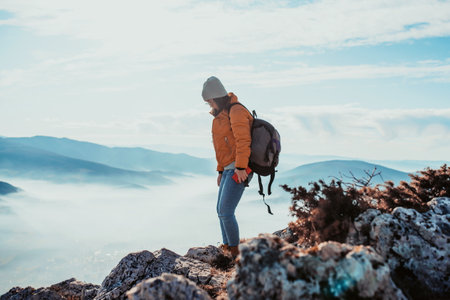Map, Compass, and Navigation Tools
In the wild and unpredictable terrain of the British fells, relying solely on your smartphone’s GPS is a rookie mistake that could land even seasoned hillwalkers in serious trouble. While modern apps offer impressive features and convenience, nothing beats the reliability of a physical map and a sturdy compass when you’re battling sideways rain on Scafell Pike or dense fog rolling over Helvellyn. The Lake District, Yorkshire Dales, and Scottish Highlands are notorious for rapidly changing weather—one minute you’re basking in sunshine, the next you’re enveloped by mist with visibility dropping to mere metres. Batteries drain fast in cold conditions and signal blackspots are common in remote areas, leaving your digital lifeline useless just when you need it most.
That’s why traditional navigation skills are non-negotiable for any hillwalker venturing into Britain’s rugged uplands. Ordnance Survey maps—meticulously detailed and iconic in British outdoor culture—should be folded into every daypack alongside a dependable Silva or Suunto compass. Even if you’ve memorised the route or downloaded all the GPX files under the sun, knowing how to read contours, identify features, and take a bearing could be the difference between a triumphant summit selfie and an embarrassing call-out to Mountain Rescue.
The British hills demand respect and self-reliance; they reward those who come prepared not just with technology, but with old-school know-how forged by generations of explorers. So before you head out onto the fells, check your kit: is your map waterproofed? Is your compass attached to its lanyard? Have you practised navigating in low visibility? Because up here, where boundaries blur between adventure and adversity, mastery of these essential tools isn’t just tradition—it’s survival.
2. Weatherproof Clothing and Layering
If there’s one thing every British hillwalker knows, it’s that the weather in the fells is as unpredictable as a wild pony on Dartmoor. One minute you’re basking in sunshine, the next you’re lashed by horizontal rain or enveloped in a biting mist. The secret to thriving—not just surviving—in these famously fickle conditions is layering up with weatherproof clothing. Here’s your guide to staying dry and comfortable, no matter what the British skies hurl your way.
The Golden Rule: Layer Like a Local
Seasoned fell-walkers swear by the three-layer system, which lets you adapt quickly as clouds scud across the hills or temperatures plummet on an exposed ridge. Here’s how it breaks down:
| Layer | Purpose | Typical Kit |
|---|---|---|
| Base Layer | Wicks sweat away from skin, keeps you dry | Merino wool or synthetic top (avoid cotton) |
| Mid Layer | Provides insulation and retains body heat | Fleece jacket, lightweight down or synthetic gilet |
| Outer Layer | Shields against wind and rain | Waterproof, breathable shell jacket and trousers |
Essential Outerwear for the Fells
No kit list is complete without a proper waterproof jacket—think GORE-TEX or similar with taped seams—and over-trousers you can slip on in seconds when that cloudburst hits. Don’t forget a beanie or buff for wind-whipped summits, and gloves even in June; cold fingers are the quickest route to misery on a blustery crag.
Packing Tips for All-Weather Readiness
Stash each layer somewhere accessible in your daypack—no one wants to be fumbling for waterproofs when the heavens open above Helvellyn. Keep a pair of dry socks in a plastic bag for emergencies, and remember: bright colours help you stand out in murky weather, crucial if visibility drops unexpectedly.
Toughing it out on Britain’s wild hills means treating every outing like an adventure into the unknown. With smart layering and bulletproof outerwear, you’ll be ready for whatever weather drama unfolds—and nothing will stop you from conquering those classic Lakeland peaks.

3. Snack Supplies and Hydration
Fueling up for a day on the British fells isn’t just about staving off hunger—it’s about making clever, calculated choices to keep your energy ticking over mile after mile. The unpredictable weather and relentless gradients demand a stash of snacks that are both portable and robust enough to withstand a battering in your pack. Classic British hill food traditions still hold strong: think slabs of flapjack, sturdy oatcakes, or a wedge of mature cheddar wrapped in greaseproof paper. These time-tested favourites won’t crumble under pressure or freeze solid if the wind whips up on Helvellyn’s ridge.
For those pushing hard or moving fast, nothing beats the convenience of individually wrapped cereal bars or a fistful of dried fruit and nuts—small but mighty, able to survive a soggy summit lunch. And don’t forget a decent water bottle or hydration bladder: even on drizzly days, sweating under layers can quickly lead to dehydration. Many seasoned fellwalkers swear by topping up with stream water (filtered, of course) when supplies run low, embracing the wildness of the landscape while keeping their load light.
On longer days out, savvy climbers might sneak in a thermos of hot tea—a nod to tradition that does wonders for morale when the clouds descend. Whatever your preference, smart sustenance is about balance: carbs for quick fuel, fats and protein for staying power, and plenty of fluids to fend off fatigue. So before you shoulder your daypack and set off into the Lakeland mist, make sure you’re kitted out with snacks that won’t let you down when the going gets tough.
4. Emergency Gear and First Aid
If you think the British fells are just a gentle wander, think again—these hills can turn from charming to challenging in a blink. Even the most seasoned hillwalker knows that mishaps happen, and it’s the prepared who live to climb another day. So what should every adventurer stash in their daypack for those “just-in-case” moments? Here’s a breakdown of must-carry emergency kit essentials that could tip the scales when things go sideways.
Essential Safety Kit for British Hills
| Item | Purpose | Top Tip |
|---|---|---|
| First-Aid Kit | Treats scrapes, blisters, sprains, and more serious injuries until help arrives | Customise with extra blister plasters and painkillers for long days out |
| Whistle | For signalling distress—six blasts at ten-second intervals is the recognised call for help in the UK | Attach to your rucksack strap for easy access |
| Bothy Bag (Group Shelter) | A lifesaver in foul weather; provides emergency shelter from wind, rain or snow while awaiting rescue or regrouping | Packs down small but can fit several people—don’t leave home without one! |
| Headtorch with Spare Batteries | Navigating in poor visibility or after nightfall if caught out late | Avoid relying on your phone torch—it drains battery fast! |
| Personal Locator Beacon (PLB) / GPS Device | Sends your location to emergency services if you’re truly stuck off-grid | Ideal for remote areas like the Lake District or Scottish Highlands |
The Bothy Bag: Your Unsung Hero
The humble bothy bag might seem like overkill on a sunny morning, but ask any Brit who’s been battered by an unexpected squall—they’ll tell you it’s worth its weight in gold. This portable group shelter can protect against hypothermia, wind-chill, and relentless drizzle, turning a potential disaster into merely an uncomfortable wait.
Quick Tips for Emergency Readiness:
- Always check your first-aid kit before heading out—replenish anything used on previous trips.
- Practice using your bothy bag and headtorch at home so you’re not fumbling in foul weather.
- Let someone know your planned route and estimated return time.
- If venturing far afield or solo, consider investing in a PLB or similar device.
- Know how to summon help: dial 999 (or 112), ask for Police, then Mountain Rescue.
The unpredictable British hills demand respect—and readiness. Carrying these core safety items ensures you’re not just surviving the adventure, but mastering it with grit and confidence, whatever the fells throw at you.
5. Footwear, Accessories, and Walking Aids
When it comes to British hill climbs, your kit is only as good as the boots on your feet. The fells are notorious for their boggy troughs, slick slabs, and unpredictable scree—so skimping on footwear isn’t just unwise, it’s borderline reckless. Lace up a pair of sturdy, waterproof walking boots with solid ankle support and grippy soles; they’ll keep you upright through sodden peat and granite boulder fields alike. Don’t trust trainers or lightweight shoes here—the Lakes and Dales will swallow them whole.
The Importance of Proper Boots
Strong, weatherproof boots are a badge of honour among seasoned fellwalkers. Look for Vibram soles for extra traction on wet stone, and always check your laces before setting off—nothing ruins a summit push like stopping to re-tie in horizontal rain.
Gaiters: Your Secret Weapon
If you’ve ever sunk shin-deep into a Lakeland mire, you’ll know gaiters aren’t just for show. These simple sleeves fend off water, mud, and heather scrapes, keeping your socks dry and morale high. Choose a robust pair that fits snugly over your boots for maximum protection when the going gets properly grim.
Walking Poles: Not Just For Ramblers
Forget any pride—walking poles are a godsend on steep descents and relentless climbs. They take strain off battered knees, help with balance crossing streams or scrambling over rocks, and offer crucial support when fatigue sets in miles from the nearest pub. Collapsible models stash neatly in your pack when not needed.
Other Handy Kit
Don’t overlook essentials like blister plasters (Compeed is king), spare laces, and a lightweight sit mat for damp lunch breaks. Sunglasses can be just as necessary as waterproofs—Cumbrian sunshine is rare but blinding when it appears. Gloves with grip work wonders scrambling up crags or handling cold metal gates. In the fells, every ounce matters; pack smart but never skimp on kit that keeps you safe and moving forward.
6. Personal Items and Responsible Access
When tackling the wild and windswept fells, your daypack should carry more than just survival gear—its also about respecting the land and ensuring your adventure leaves no unwelcome trace. Comfort, etiquette, and environmental responsibility are deeply woven into British outdoor culture. Start with essentials for personal comfort: pack a small stash of biodegradable wipes for those moments when you need to freshen up or deal with muddy scrapes—just be sure they’re eco-friendly and pack them out if used. Carry a dedicated rubbish bag (or bin liner in local parlance); it’s not just for your own litter but perfect for collecting stray wrappers or bottles left by less considerate ramblers. This small act is a proud tradition among hillwalkers, keeping the fells as pristine as you found them.
Next, remember that British hills are crisscrossed with public rights of way, ancient stone walls, and sheep-filled pastures. Always close gates behind you (leave gates as you find them), avoid disturbing livestock, and stick to marked paths to prevent erosion and protect fragile habitats. It’s good form to greet fellow walkers with a friendly nod or “afternoon!”—hill camaraderie is alive and well. Lastly, take a moment before you set off to brush up on the Countryside Code: respect everyone, protect the environment, enjoy the outdoors. These simple rules ensure every explorer can experience the raw beauty of Britain’s uplands without leaving scars on the landscape. Packing with these principles in mind turns a tough climb into a true adventure—one that honours both nature and tradition.


